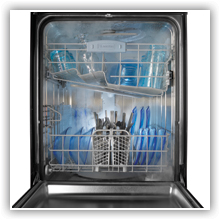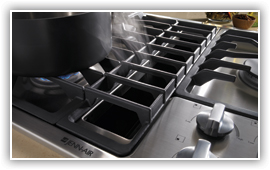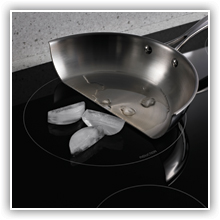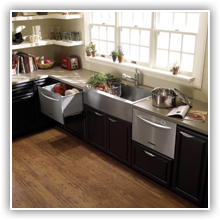Environmentally-Friendly Appliances
By Terri Connett, Senior Manager Contract Marketing and Design at Whirlpool Corporation
The combination of a turbulent economy and the adoption of sustainable living practices have made today’s homeowners more eco-conscious and discerning than ever before. And as technology continues to change how people live, work, and relax in their homes, the role of the kitchen is transforming. In short, homeowners expect more from their kitchens and the appliances featured therein.

In this article, we’ll review a few of the latest kitchen appliance trends, including open-plan kitchens, induction cooking and steam technology, to help make appliance selection easier for both designers and consumers.
Open Kitchen, Flexible Appliance

The increasing popularity of informal entertaining, as well as integrated kitchen and living spaces, is causing open-plan kitchens to gain momentum. Open-plan kitchens allow people to move from room to room more freely. More importantly, they allow the cook to interact with guests and family members who may be watching television, doing work or homework, playing games or conversing.
With an open kitchen comes the demand for appliances that offer flexibility of placement and cater better to clients’ lifestyles. A single ENERGY STAR® qualified drawer dishwasher can be used as a stand-alone in a small kitchen or as a supplemental or second dishwasher. From an accessibility perspective, placing a single drawer dishwasher on each side of a sink means no bending to reach the bottom rack, and it allows clients to wash smaller loads and use less water and power.
Another design requirement in today’s open kitchens is improved ventilation to help evacuate smoke, steam and odors. Proximity downdraft ventilation eliminates the need for an overhead hood, clearing the way for more innovative kitchen plans and making it easy for cooktops to be installed in an island or peninsula. Also, since the blower is located below the counter and not at eye/ear level, downdraft ventilation produces less noise.
Additionally, homeowners are feeling less tied to traditional notions of kitchen design. For example, those who regularly entertain are opting for additional dishwashers or cooktops, or moving beverage centers and drawer dishwashers to entertainment areas outside the kitchen.
Induction Cooktops

As one of the newer sustainable kitchen options, induction cooktops, are gaining popularity in the design community. According to the 2011 NKBA Kitchen and Bath Design Trend survey, 34 percent of the 100 members surveyed had specified induction cooktops in the final three months of 2010, up 8 percent from last year’s survey.
Induction cooktops don’t waste energy or overheat the kitchen. With induction technology, the cooking vessel becomes the heat source, instead of electrical coils or burning gas used in traditional conduction cooking. This heating method allows for faster, more powerful cooking.
The direct-to-vessel heating makes induction cooktops very energy-efficient. The U.S. Department of Energy has established that the typical efficiency of induction cooktops is 84 percent, as opposed to 40 percent efficiency with gas cooktops and 60 percent efficiency with conventional electric cooktops. With that kind of energy efficiency, induction cooktops are an excellent choice for projects that emphasize sustainability.
Full Steam Ahead

Steam technology has been gaining momentum over the past few years because of its versatility. It’s an effective way to clean and freshen, and it also helps enhance cooking results by locking in the natural flavor and moisture of food.
In regards to baking, steam technology was previously used only by professional chefs. Now, it’s available to homeowners in ranges and ovens, to put homeowners on the path to gourmet results. Ranges and ovens with this technology provide moisture at the right time to enhance food flavors without the hassle of covering, basting, misting or water baths. For maximum versatility, these ovens can use a combination of convection and steam, convection alone or thermal alone.
Many dishwasher manufacturers offer models with a steam option to enhance an existing wash cycle, such as the china cycle, to produce an even more lustrous shine on glassware. With this high-heat option, dishwashers reduce stubborn residue and spots from glasses, delivering more powerful cleaning performance than ever before. And, these dishwashers also are ENERGY STAR qualified.
To ease oven cleaning, some electric ranges are equipped with a steam cleaning option to spot-clean light spills in the oven in about 20 minutes. This steam cleaning option is a popular supplement to the traditional self-clean cycle.

Even in the laundry room, steam is beneficial. Steam technology in the washer can help deep clean and extract tough stains. In the dryer, steam minimizes trips to the drycleaner by relaxing wrinkles and removing odors.
Today’s homeowners have come to expect products that are as eco-efficient as they are innovative, reliable and trendworthy. Savvy manufacturers realize that making appliances more sustainable isn’t a sacrifice – it’s an opportunity to innovate, save resources and better meet client demand.
To find an NKBA member professional who can help you plan your next kitchen or bathroom remodel, visit NKBA.org/ProSearch.







